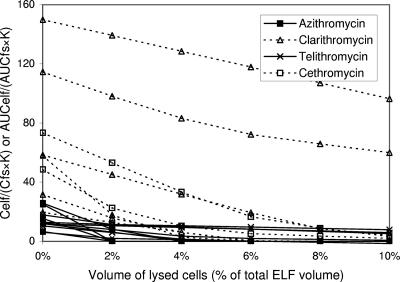FIG. 4.
Impact of number of cells lysed during the processing of BAL specimens on the measurement of ELF concentrations of azithromycin, clarithromycin, telithromycin, and cethromycin. AUCelf/(AUCfs·K) (or Celf/[Cfs·K]) ratios are plotted against the volume percentage of lysed cells in ELF. Constant K reflects the capacity of antibiotics for penetration through alveolar epithelial cells (see text). Multiple lines of the same antibiotic are drawn based on different data sets. Because of the very high intracellular concentrations, the rapid drop of AUCelf/(AUCfs·K) (or Celf/Cfs·K) ratios from very high levels to around 1 with increasing lysis of cells is a general pattern in macrolides and ketolides. It means that lysis of a proportion of cells in the media may explain the high concentrations of macrolides and ketolides in ELF. While the ratios fail to reach ≤1 in some data sets for the antibiotics, the variety seems to be derived from very high ELF and intracellular concentrations of the antibiotics compared to their free serum levels, for trivial errors in measurement of the antibiotic concentrations in those sites will skew the concentration ratios by a great extent.

